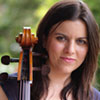
Named "rising star" by The Strad magazine, Evva Mizerska is an award-winning cellist, recitalist and chamber musician. Highly sought-after performer, she has appeared as a soloist or recitalist in venues such as the Royal Festival Hall, the Purcell Room (Queen Elizabeth Hall), St George's Bristol amongst the others in the UK; other performances include duo or trio recitals in Austria, Brazil, the Czech Republic, Slovakia, France, Germany, Italy and Poland as well as live broadcasts for the BBC3 and the Polish Radio.
Born in Poland, Evva graduated from the Frédéric Chopin Academy of Music in Warsaw. She later completed the PGDip and MMus studies at Trinity College of Music in London, where she learnt with Richard Markson. She has also received tuition from Yonty Solomon, Bernard Greenhouse, Raphael Sommer and Erling Blöndal Bengtsson. Evva has been awarded numerous prizes, including the first prize at the Seventh International Leoš Janáček Competition in Brno, the Vivian Joseph Cello Prize and the Leonard Smith Duo Prize in London as well as scholarships and grants in the UK, Germany and the USA.
Evva currently lives in London where she is a cello lecturer at Morley College. Her chamber music partners include pianist
Emma Abbate (Evva&Emma Duo) and the
Veles Ensemble (a string trio, of which she is a founding member).
Evva's recording label is Toccata Classics, where she has released three CDs with pianist Emma Abbate and two others with Veles Ensemble. She has also featured in recordings for Naxos and the Polish label DUX.

